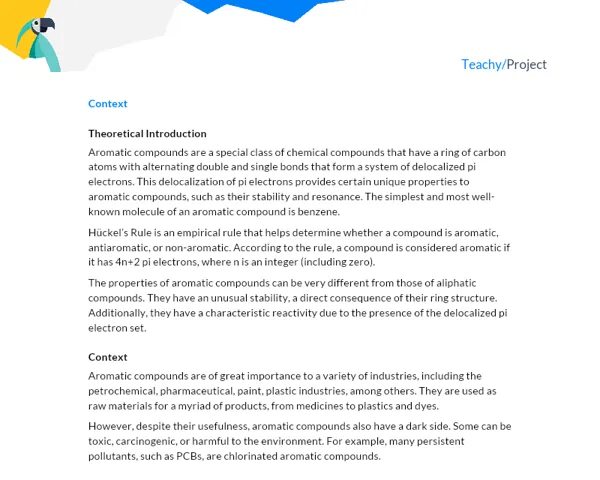Contextualization
Colloids are heterogeneous mixtures consisting of two or more phases, that is, the dispersed phase (solids or liquids), also called the 'internal phase,' and the dispersion medium or 'external phase.' Everyday common water, for example, is a colloid in which the particles are mineral substances dissolved in water. Colloidal particles are larger than molecules but smaller than particles found in suspensions, and their sizes are measured in nanometers.
Colloids have interesting characteristics, such as the ability to scatter light in various directions, a phenomenon known as the Tyndall effect. Additionally, the particles present in colloids have a constant and random movement known as Brownian motion. These characteristics are essential for the correct identification and classification of colloids.
There is a wide range of applications of colloids in different areas. In the food industry, many products are colloids, such as mayonnaise, jelly, ice cream, butter, margarine, among others. In medicine, colloids are used in the production of medicines and cosmetics. In the field of nanotechnology, colloids have impressive applications, such as creating self-cleaning surfaces and invisible ink.
Studying colloids opens up possibilities to explore numerous practical applications, from understanding the texture and stability of foods to developing new materials with unique properties. By understanding the fundamental concepts of colloids, you will be facing a vast universe of applications that impact our daily lives in surprising ways.
To deepen your knowledge, I suggest the following resources:
-
Book: General Chemistry and Chemical Reactions - Volume 2. (KOTZ, John C.; TREICHEL Jr., Paul M.; TOWNSEND, John) Cengage Learning Publisher. This book addresses the topic of colloids in a didactic and profound way.
-
Website: Brazil School - Colloids: http://brasilescola.uol.com.br/quimica/coloides.htm. This site offers an accessible explanation and additional information on the topic of colloids.
-
Video: Chemistry in Action - Colloids: https://www.youtube.com/watch?v=C1WeiA1BBd0. This video presents in a relaxed manner the concept of colloids, their types, and practical examples.
Practical Activity
Activity Title: 'Exploring the World of Colloids'
Project Objective:
The objective of this project is to investigate and understand the nature of colloids through practical experiments, exploring their properties and everyday applications. By the end of the project, students should be able to identify colloids and explain their behaviors and uses.
Detailed Project Description:
This project is intended for groups of 3 to 5 students and should be carried out over a month. The project involves conducting practical experiments, literature research, and writing a report.
First, students will perform two experiments to observe the properties of colloids, specifically Brownian motion and the Tyndall effect. Next, they will conduct a critical analysis of these observations, connecting them to everyday examples of colloids.
Finally, students should write a detailed report on the activities carried out, explaining what colloids are, their properties, the experiments conducted, and the observations made, as well as discussing examples of colloids in everyday life and their practical applications.
Required Materials:
- Milk
- Water
- Flour
- Light beam (flashlight)
- Microscope
- Pollen grains
- Microscope slides
- Transparent glass cups
- Spoons
- Scale
Detailed Step-by-Step for Activity Execution:
EXPERIMENT 1: Observation of Brownian Motion
- Place some pollen grains in water on a microscope slide.
- Observe the sample under the microscope and record the movement of the pollen particles.
EXPERIMENT 2: Observation of the Tyndall Effect
- Prepare two solutions in glass cups: one with pure water and another with a mixture of flour and water.
- Illuminate the solutions with a light beam in a dark environment and observe the difference between them.
In parallel with the experiments, students should research and discuss practical applications of colloids, such as in the food industry, medicine, cosmetics, textile industry, among others. The group should relate the properties observed in the experiments to the usefulness of these properties in the practical applications of colloids.
Project Deliverables and Report:
The final product should be a written report, including the following points:
-
Introduction: Contextualize the topic of colloids, their relevance, real-world application, and the objective of this project. Include a literature review with the research sources used.
-
Development: Describe the theory of colloids and their properties. Report in detail the methodology of the experiments conducted, present the results obtained and analyze them, linking the results to the theory studied. Discuss examples of colloids in everyday life and their practical applications.
-
Conclusion: Summarize the main points discussed, recap what colloids are and their properties, comment on the experiments conducted and the results obtained. Explicit the learnings from the project and how they relate to the practical applications of colloids.
-
Bibliography: List all sources of information used for the project, including books, websites, videos, etc.
The report should be submitted in digital format and on paper, if possible, and should be presented to the group of classmates and the teacher. The oral presentation should be well-structured and clear, highlighting the main discoveries and learnings from the project.


